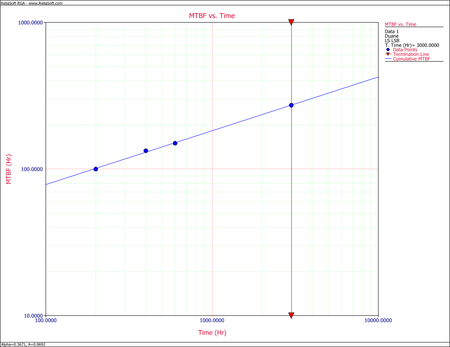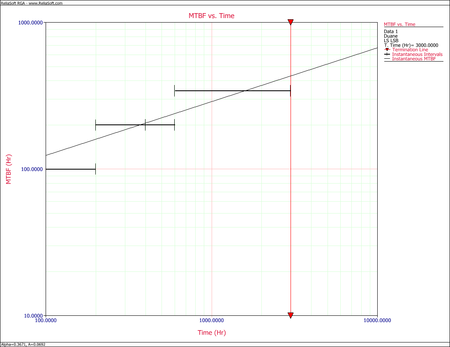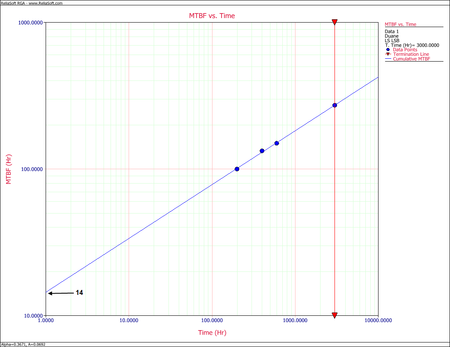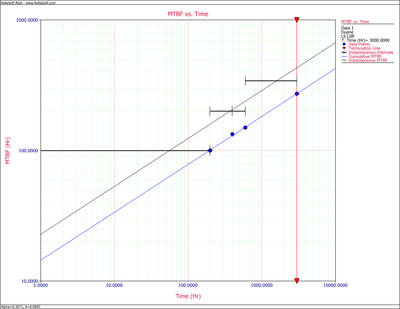Duane Model Examples: Difference between revisions
Kate Racaza (talk | contribs) No edit summary |
Kate Racaza (talk | contribs) No edit summary |
||
| Line 1: | Line 1: | ||
<noinclude>{{Banner RGA Examples}} | <noinclude>{{Banner RGA Examples}} | ||
'' | ''These examples appear in the [[Duane Model|Reliability Growth and Repairable System Analysis Reference book]]''. | ||
This page presents two alternative methods for estimating the parameters of the Duane model: 1) using a graphical approach 2) using a mathematical approach. | This page presents two alternative methods for estimating the parameters of the Duane model: 1) using a graphical approach 2) using a mathematical approach. | ||
Revision as of 20:43, 21 November 2013
New format available! This reference is now available in a new format that offers faster page load, improved display for calculations and images and more targeted search.
As of January 2024, this Reliawiki page will not continue to be updated. Please update all links and bookmarks to the latest references at RGA examples and RGA reference examples.
These examples appear in the Reliability Growth and Repairable System Analysis Reference book.
This page presents two alternative methods for estimating the parameters of the Duane model: 1) using a graphical approach 2) using a mathematical approach.
Graphical Approach
A complex system's reliability growth is being monitored and the data set is given in the table below.
| Point Number | Cumulative Test Time(hours) | Cumulative Failures | Cumulative MTBF(hours) | Instantaneous MTBF(hours) |
|---|---|---|---|---|
| 1 | 200 | 2 | 100.0 | 100 |
| 2 | 400 | 3 | 133.0 | 200 |
| 3 | 600 | 4 | 150.0 | 200 |
| 4 | 3,000 | 11 | 273.0 | 342.8 |
Do the following:
- Plot the cumulative MTBF growth curve.
- Write the equation of this growth curve.
- Write the equation of the instantaneous MTBF growth model.
- Plot the instantaneous MTBF growth curve.
Solution
- Given the data in the second and third columns of the above table, the cumulative MTBF, [math]\displaystyle{ {{\hat{m}}_{c}}\,\! }[/math], values are calculated in the fourth column. The information in the second and fourth columns are then plotted. The first figure below shows the cumulative MTBF while the second figure below shows the instantaneous MTBF. It can be seen that a straight line represents the MTBF growth very well on log-log scales.
Cumulative MTBF plot Instantaneous MTBF plot By changing the x-axis scaling, you are able to extend the line to [math]\displaystyle{ T=1\,\! }[/math]. You can get the value of [math]\displaystyle{ b\,\! }[/math] from the graph by positioning the cursor at the point where the line meets the y-axis. Then read the value of the y-coordinate position at the bottom left corner. In this case, [math]\displaystyle{ b\,\! }[/math] is approximately 14 hours. The next figure illustrates this.
Cumulative MTBF plot for [math]\displaystyle{ b \approx 14\,\! }[/math] at [math]\displaystyle{ T=1\,\! }[/math] Another way of determining [math]\displaystyle{ b\,\! }[/math] is to calculate [math]\displaystyle{ \alpha \,\! }[/math] by using two points on the fitted straight line and substituting the corresponding [math]\displaystyle{ {{\hat{m}}_{c}}\,\! }[/math] and [math]\displaystyle{ T\,\! }[/math] values into:
- [math]\displaystyle{ \alpha =\frac{\ln \left( {{{\hat{m}}}_{{{c}_{2}}}} \right)-\ln \left( {{{\hat{m}}}_{{{c}_{1}}}} \right)}{\ln \left( {{T}_{_{2}}} \right)-\ln \left( {{T}_{_{1}}} \right)}\,\! }[/math]
Then substitute this [math]\displaystyle{ \alpha \,\! }[/math] and choose a set of values for [math]\displaystyle{ {{\hat{m}}_{{{c}_{1}}}}\,\! }[/math] and [math]\displaystyle{ {{T}_{_{1}}}\,\! }[/math] into the cumulative MTBF equation, [math]\displaystyle{ {{\hat{m}}_{c}}=b{{T}^{\alpha }}\,\! }[/math], and solve for [math]\displaystyle{ b\,\! }[/math]. The slope of the line, [math]\displaystyle{ \alpha \,\! }[/math], may also be found from the linearized form of the cumulative MTBF equation, or :
- [math]\displaystyle{ \alpha =\frac{\ln \left( {{{\hat{m}}}_{c}} \right)-\ln (b)}{\ln (T)-\ln (1)}\,\! }[/math]
Using the cumulative MTBF plot for the example, at [math]\displaystyle{ {{T}_{_{1}}}=200\,\! }[/math] hours, [math]\displaystyle{ {{\hat{m}}_{{{c}_{1}}}}=100\,\! }[/math] hours, and [math]\displaystyle{ {{T}_{_{2}}}=3,500\,\! }[/math] hours, [math]\displaystyle{ {{\hat{m}}_{{{c}_{2}}}}=300\,\! }[/math] hours. From the cumulative MTBF plot for [math]\displaystyle{ b=14\,\! }[/math] hours when [math]\displaystyle{ T=1\,\! }[/math], substituting the first set of values, [math]\displaystyle{ b=14\,\! }[/math] hours and [math]\displaystyle{ \ln 1=0\,\! }[/math], into the equation yields:
- [math]\displaystyle{ \begin{align} {{\alpha }_{1}}= & \frac{\ln (100)-\ln (14)}{\ln (200)-\ln (1)} \\ = & 0.3711 \end{align}\,\! }[/math]
- Substituting the second set of values, [math]\displaystyle{ b=14\,\! }[/math] hours and [math]\displaystyle{ \ln 1=0,\,\! }[/math] into the equation yields:
- [math]\displaystyle{ \begin{align} {{\alpha }_{2}}= & \frac{\ln (300)-\ln (14)}{\ln (3,500)-\ln (1)} \\ = & 0.3755 \end{align}\,\! }[/math]
- Now the equation for the cumulative MTBF growth curve is:
- [math]\displaystyle{ {{\hat{m}}_{c}}=14\cdot {{T}^{\text{ }0.3733}}\,\! }[/math]
- Using the following equation for the instantaneous MTBF, or
- [math]\displaystyle{ {{m}_{i}} = \frac{1}{1-\alpha }{{{\hat{m}}}_{c}},:\ \ \alpha \not{=}1 \,\! }[/math]
- [math]\displaystyle{ \begin{align} {{\hat{m}}_{i}}=\frac{1}{1-0.3733} \cdot {{14T}^{0.3733}} \end{align}\,\! }[/math]
Cumulative and Instantaneous MTBF vs. Time plot
Mathematical Approach
Example 1
Using the same data set from the graphical approach example, estimate the parameters of the MTBF model using least squares.
Solution
From the data table:
- [math]\displaystyle{ \begin{align} \underset{i=1}{\overset{n}{\mathop \sum }}\,\ln ({{T}_{i}})&= & 25.693 \\ \underset{i=1}{\overset{n}{\mathop \sum }}\,\ln ({{T}_{i}})\ln ({{m}_{ci}})&= & 130.66 \\ \underset{i=1}{\overset{n}{\mathop \sum }}\,\ln ({{m}_{ci}})&= & 20.116 \\ \underset{i=1}{\overset{n}{\mathop \sum }}\,{{\left[ \ln ({{T}_{i}}) \right]}^{2}}&= & 168.99 \end{align}\,\! }[/math]
Obtain the value of [math]\displaystyle{ \hat{\alpha}\,\! }[/math] from the least squares analysis, or:
- [math]\displaystyle{ \begin{align} \hat{\alpha }&=\frac{\underset{i=1}{\overset{n}{\mathop{\sum }}}\,\ln ({{T}_{i}})\ln ({{m}_{ci}})-\tfrac{\underset{i=1}{\overset{n}{\mathop{\sum }}}\,\ln ({{T}_{i}})\underset{i=1}{\overset{n}{\mathop{\sum }}}\,\ln ({{m}_{ci}})}{n}}{\underset{i=1}{\overset{n}{\mathop{\sum }}}\,{{\left[ \ln ({{T}_{i}}) \right]}^{2}}-\tfrac{{{\left( \underset{i=1}{\overset{n}{\mathop{\sum }}}\,\ln ({{T}_{i}}) \right)}^{2}}}{n}} \\ & = \frac{130.66-\tfrac{25.693\cdot 20.116}{4}}{168.99-\tfrac{{{25.693}^{2}}}{4}} \\ & = 0.3671 \end{align}\,\! }[/math]
Obtain the value [math]\displaystyle{ \hat{b}\,\! }[/math] from the least squares analysis, or:
- [math]\displaystyle{ \begin{align} \hat{b}&={{e}^{\tfrac{1}{n}\left[ \underset{i=1}{\overset{n}{\mathop{\sum }}}\,\ln ({{m}_{ci}})-\alpha \underset{i=1}{\overset{n}{\mathop{\sum }}}\,\ln ({{T}_{i}}) \right]}} \\ & = {{e}^{\tfrac{1}{4}(20.116-0.3671\cdot 25.693)}} \\ & = 14.456 \end{align}\,\! }[/math]
Therefore, the cumulative MTBF becomes:
- [math]\displaystyle{ \begin{align} \hat{m_{c}}&=bT^{\alpha } \\ &=14.456\cdot {{T}^{0.3671}} \\ \end{align}\,\! }[/math]
The equation for the instantaneous MTBF growth curve is:
- [math]\displaystyle{ \begin{align} {{\hat{m}}_{i}}&=\frac{1}{1-\alpha }{{{\hat{m}}}_{c}},:\ \ \alpha \not{=}1 \\ &=\frac{1}{1-0.3671}(14.456){{T}^{0.3671}} \\ \end{align}\,\! }[/math]
Example 2
For the data given in columns 1 and 2 of the following table, estimate the Duane parameters using least squares.
| (1)Failure Number | (2)Failure Time(hours) | (3)[math]\displaystyle{ \ln{T_i}\,\! }[/math] | (4)[math]\displaystyle{ \ln{T_i}^2\,\! }[/math] | (5)[math]\displaystyle{ m_c\,\! }[/math] | (6)[math]\displaystyle{ \ln{m_c}\,\! }[/math] | (7)[math]\displaystyle{ \ln{m_c}\cdot\ln{T_i}\,\! }[/math] |
|---|---|---|---|---|---|---|
| 1 | 9.2 | 2.219 | 4.925 | 9.200 | 2.219 | 4.925 |
| 2 | 25 | 3.219 | 10.361 | 12.500 | 2.526 | 8.130 |
| 3 | 61.5 | 4.119 | 16.966 | 20.500 | 3.020 | 12.441 |
| 4 | 260 | 5.561 | 30.921 | 65.000 | 4.174 | 23.212 |
| 5 | 300 | 5.704 | 32.533 | 60.000 | 4.094 | 23.353 |
| 6 | 710 | 6.565 | 43.103 | 118.333 | 4.774 | 31.339 |
| 7 | 916 | 6.820 | 46.513 | 130.857 | 4.874 | 33.241 |
| 8 | 1010 | 6.918 | 47.855 | 126.250 | 4.838 | 33.470 |
| 9 | 1220 | 7.107 | 50.504 | 135.556 | 4.909 | 34.889 |
| 10 | 2530 | 7.836 | 61.402 | 253.000 | 5.533 | 43.359 |
| 11 | 3350 | 8.117 | 65.881 | 304.545 | 5.719 | 46.418 |
| 12 | 4200 | 8.343 | 69.603 | 350.000 | 5.858 | 48.872 |
| 13 | 4410 | 8.392 | 70.419 | 339.231 | 5.827 | 48.895 |
| 14 | 4990 | 8.515 | 72.508 | 356.429 | 5.876 | 50.036 |
| 15 | 5570 | 8.625 | 74.393 | 371.333 | 5.917 | 51.036 |
| 16 | 8310 | 9.025 | 81.455 | 519.375 | 6.253 | 56.431 |
| 17 | 8530 | 9.051 | 81.927 | 501.765 | 6.218 | 56.282 |
| 18 | 9200 | 9.127 | 83.301 | 511.111 | 6.237 | 56.921 |
| 19 | 10500 | 9.259 | 85.731 | 552.632 | 6.315 | 58.469 |
| 20 | 12100 | 9.401 | 88.378 | 605.000 | 6.405 | 60.215 |
| 21 | 13400 | 9.503 | 90.307 | 638.095 | 6.458 | 61.375 |
| 22 | 14600 | 9.589 | 91.945 | 663.636 | 6.498 | 62.305 |
| 23 | 22000 | 9.999 | 99.976 | 956.522 | 6.863 | 68.625 |
| Sum = | 173.013 | 1400.908 | 7600.870 | 121.406 | 974.242 |
Solution
To estimate the parameters using least squares, the values in columns 3, 4, 5, 6 and 7 are calculated. The cumulative MTBF, [math]\displaystyle{ {{m}_{c}}\,\! }[/math], is calculated by dividing the failure time by the failure number. The value of [math]\displaystyle{ \hat{\alpha }\,\! }[/math] is:
- [math]\displaystyle{ \begin{align} \hat{\alpha }&=\frac{\underset{i=1}{\overset{n}{\mathop{\sum }}}\,\ln ({{T}_{i}})\ln ({{m}_{ci}})-\tfrac{\underset{i=1}{\overset{n}{\mathop{\sum }}}\,\ln ({{T}_{i}})\underset{i=1}{\overset{n}{\mathop{\sum }}}\,\ln ({{m}_{ci}})}{n}}{\underset{i=1}{\overset{n}{\mathop{\sum }}}\,{{\left[ \ln ({{T}_{i}}) \right]}^{2}}-\tfrac{{{\left( \underset{i=1}{\overset{n}{\mathop{\sum }}}\,\ln ({{T}_{i}}) \right)}^{2}}}{n}} \\ & = \frac{974.242-\tfrac{173.013\cdot 121.406}{23}}{1400.908-\tfrac{{{(173.013)}^{2}}}{23}} \\ & = 0.6133 \end{align}\,\! }[/math]
The estimator of [math]\displaystyle{ b\,\! }[/math] is estimated to be:
- [math]\displaystyle{ \begin{align} \hat{b}&={{e}^{\tfrac{1}{n}\left[ \underset{i=1}{\overset{n}{\mathop{\sum }}}\,\ln ({{m}_{ci}})-\alpha \underset{i=1}{\overset{n}{\mathop{\sum }}}\,\ln ({{T}_{i}}) \right]}} \\ & = {{e}^{\tfrac{1}{23}(121.406-0.6133\cdot 173.013)}} \\ & = 1.9453 \end{align}\,\! }[/math]
Therefore, the cumulative MTBF becomes:
- [math]\displaystyle{ \begin{align} \hat{m_{c}}&= bT^{\alpha } \\ & =1.9453\cdot {{T}^{0.613}} \\ \end{align}\,\! }[/math]
Using the equation for the instantaneous MTBF growth curve,
- [math]\displaystyle{ \begin{align} {{\hat{m}}_{i}}&=\frac{1}{1-\alpha }{{{\hat{m}}}_{c}},:\ \ \alpha \not{=}1 \\ & =\frac{1}{1-0.613}(1.945){{T}^{0.613}} \\ \end{align}\,\! }[/math]
Example 3
For the data given in the following table, estimate the Duane parameters using least squares.
| Run Number | Failed Unit | Test Time 1 | Test Time 2 | Cumulative Time |
|---|---|---|---|---|
| 1 | 1 | 0.2 | 2.0 | 2.2 |
| 2 | 2 | 1.7 | 2.9 | 4.6 |
| 3 | 2 | 4.5 | 5.2 | 9.7 |
| 4 | 2 | 5.8 | 9.1 | 14.9 |
| 5 | 2 | 17.3 | 9.2 | 26.5 |
| 6 | 2 | 29.3 | 24.1 | 53.4 |
| 7 | 1 | 36.5 | 61.1 | 97.6 |
| 8 | 2 | 46.3 | 69.6 | 115.9 |
| 9 | 1 | 63.6 | 78.1 | 141.7 |
| 10 | 2 | 64.4 | 85.4 | 149.8 |
| 11 | 1 | 74.3 | 93.6 | 167.9 |
| 12 | 1 | 106.6 | 103 | 209.6 |
| 13 | 2 | 195.2 | 117 | 312.2 |
| 14 | 2 | 235.1 | 134.3 | 369.4 |
| 15 | 1 | 248.7 | 150.2 | 398.9 |
| 16 | 2 | 256.8 | 164.6 | 421.4 |
| 17 | 2 | 261.1 | 174.3 | 435.4 |
| 18 | 2 | 299.4 | 193.2 | 492.6 |
| 19 | 1 | 305.3 | 234.2 | 539.5 |
| 20 | 1 | 326.9 | 257.3 | 584.2 |
| 21 | 1 | 339.2 | 290.2 | 629.4 |
| 22 | 1 | 366.1 | 293.1 | 659.2 |
| 23 | 2 | 466.4 | 316.4 | 782.8 |
| 24 | 1 | 504 | 373.2 | 877.2 |
| 25 | 1 | 510 | 375.1 | 885.1 |
| 26 | 2 | 543.2 | 386.1 | 929.3 |
| 27 | 2 | 635.4 | 453.3 | 1088.7 |
| 28 | 1 | 641.2 | 485.8 | 1127 |
| 29 | 2 | 755.8 | 573.6 | 1329.4 |
Solution
The solution to this example follows the same procedure as the previous example. Therefore, from the table shown above:
- [math]\displaystyle{ \begin{align} \underset{i=1}{\overset{29}{\mathop \sum }}\,\ln ({{T}_{i}})= & 154.151 \\ \underset{i=1}{\overset{29}{\mathop \sum }}\,\ln {{({{T}_{i}})}^{2}}= & 902.592 \\ \underset{i=1}{\overset{29}{\mathop \sum }}\,\ln ({{m}_{c}})= & 82.884 \\ \underset{i=1}{\overset{29}{\mathop \sum }}\,\ln ({{T}_{i}})\cdot \ln ({{m}_{c}})= & 483.154 \end{align}\,\! }[/math]
For least squares, the value of [math]\displaystyle{ \alpha \,\! }[/math] is:
- [math]\displaystyle{ \begin{align} \hat{\alpha }&=\frac{\underset{i=1}{\overset{n}{\mathop{\sum }}}\,\ln ({{T}_{i}})\ln ({{m}_{ci}})-\tfrac{\underset{i=1}{\overset{n}{\mathop{\sum }}}\,\ln ({{T}_{i}})\underset{i=1}{\overset{n}{\mathop{\sum }}}\,\ln ({{m}_{ci}})}{n}}{\underset{i=1}{\overset{n}{\mathop{\sum }}}\,{{\left[ \ln ({{T}_{i}}) \right]}^{2}}-\tfrac{{{\left( \underset{i=1}{\overset{n}{\mathop{\sum }}}\,\ln ({{T}_{i}}) \right)}^{2}}}{n}} \\ & = \frac{483.154-\tfrac{154.151\cdot 82.884}{29}}{902.592-\tfrac{{{(154.151)}^{2}}}{29}} \\ & = 0.5115 \end{align}\,\! }[/math]
The value of the estimator [math]\displaystyle{ b\,\! }[/math] is:
- [math]\displaystyle{ \begin{align} \hat{b}&={{e}^{\tfrac{1}{n}\left[ \underset{i=1}{\overset{n}{\mathop{\sum }}}\,\ln ({{m}_{ci}})-\alpha \underset{i=1}{\overset{n}{\mathop{\sum }}}\,\ln ({{T}_{i}}) \right]}} \\ & = {{e}^{\tfrac{1}{29}(82.884-0.5115\cdot 154.151)}} \\ & = 1.1495 \end{align}\,\! }[/math]
Therefore, the cumulative MTBF is:
- [math]\displaystyle{ \begin{align} \hat{m_{c}}&=bT^{\alpha } & = 1.1495\cdot {{T}^{0.5115}} \end{align}\,\! }[/math]
Using the equation for the instantaneous MTBF growth,
- [math]\displaystyle{ \begin{align} {{\hat{m}}_{i}}&=\frac{1}{1-\alpha }{{{\hat{m}}}_{c}},:\ \ \alpha \not{=}1 \\ & =\frac{1}{1-0.5115}(1.1495){{T}^{0.5115}} \end{align}\,\! }[/math]





